
ƒ / [ 1642 ]
CYNOGLOSSUM sylvaticum.
Green-leaved Hound 's -tongu e.
PENTANDRIA Monogynia.
G en. Char. Cor. funnel-shaped; orifice closed with
arched valves. Seeds depressed, fixed to the style
by their inner margin only.
Spec. C har. Stamina shorter than the corolla. Leaves
lanceolate, somewhat spatulate, shining, partly naked,
rough beneath.
Syn. Cynoglossum sylvaticum. Haenhe in Jacq. Coll,
v. 2. 77. Sm. FI. Brit. 2 1 6 . With. 2 2 8 . Hull. 4 6 .
Sym. 5 1 . Sibth. 70.
C. officinale y. Linn. Sp. PI. 193. (3. Huds. 80.
Cynoglossa folio virente. Raii Syn. 2 2 6 .
T h e plant from which our specimen was taken was collected
by the Rev. Dr. Abbot in Oxfordshire. This is unquestionably
a distinct species from C. officinale, t. 921, Its leaves
are more dilated at the base, of a bright and shining green,
destitute of the soft downiness and grey hue of that common
plant, though more or less hairy underneath : both sides are
roughish with small tubercles. Calyx hairy. Flowers at first
reddish, assuming a blueish hue as they advance to maturity.
The whole herb is almost without any foetid smell. The root
is biennial, and the flowers appear in June. Mr. J. D. Sowerby
has observed that wherever a flower is cut off, a sweet honeylike
juice oozes from the wound.
This species is found about hedges in several parts o f England,
especially in Essex; but, like many other biennials or
annuals, it often changes its abode. It is also a native of
Switzerland, being Haller’s Cynoglossum, No. 588.